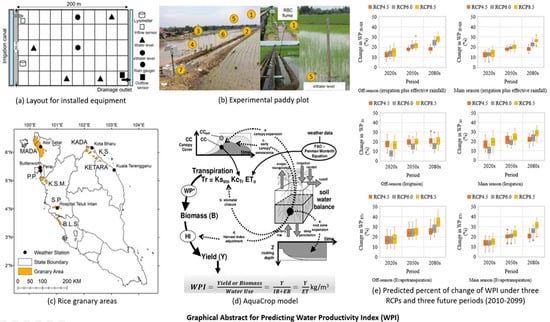Predicting Climate Change Impact on Water Productivity of Irrigated Rice in Malaysia Using FAO-AquaCrop Model
Abstract
:1. Introduction
2. Materials and Methods
2.1. Location and Field Investigation
2.2. Climate Data and Downscaling Climate Variables
2.3. AquaCrop Model
2.3.1. Model Description
2.3.2. Model Calibration
2.3.3. Model Validation Criteria
2.4. Simulation for Future (2010–2099)
2.4.1. Crop Yield
2.4.2. Actual Crop Evapotranspiration and Crop Coefficient
2.4.3. Water Productivity
3. Results and Discussion
3.1. Future Climate Change
3.2. Reference Evapotranspiration
3.3. Performance of AquaCrop Model
3.4. Effect of CO2 on Yield and ETc under Projected Climate Change
3.5. Projected Yield
3.6. Projected Water Productivity of Rice
4. Conclusions
Author Contributions
Funding
Institutional Review Board Statement
Informed Consent Statement
Data Availability Statement
Acknowledgments
Conflicts of Interest
References
- Gitz, V.; Meybeck, A. Climate change and food security: Risks and responses. Food Agric. Organ. United Nations Rep. 2016, 110, 1–98. [Google Scholar]
- Lal, R.; Uphoff, N.; Stewart, B.A.; Hansen, D.O. Climate Change and Global Food Security; CRC Press: Boca Raton, FL, USA, 2005; pp. 1–744. [Google Scholar]
- Masson-Delmotte, V.P.; Zhai, H.-O.; Pörtner, D.; Roberts, J.; Skea, P.R.; Shukla, A.; Pirani, W.; Moufouma-Okia, C.; Péan, R.P. (Eds.) IPCC: Summary for Policymakers. In Global Warming of 1.5 °c. An IPCC Special Report on the Impacts of Global Warming of 1.5 °C above Pre-Industrial Levels and Related Global Greenhouse Gas Emission Pathways, in the Context of Strengthening the Global Response to the Threat of Climate Change, Sustainable Development, and Efforts to Eradicate Poverty; Intergovernmental Panel on Climate Change: Geneva, Switzerland, 2018; pp. 31–116. [Google Scholar]
- Oki, T.; Kanae, S. Global Hydrological Cycles and Freshwater Resources Fresh water. Science 2006, 313, 1068–1073. [Google Scholar] [CrossRef] [Green Version]
- Zaki, M.M.M.; Ercan, A.; Ishida, K.; Kavvas, L.M.; Chen, Z.Q.; Jang, H.Q. Impacts of Climate Change on the Hydro-Climate of Peninsular Malaysia. Water 2019, 11, 1798. [Google Scholar]
- Fatimah, K. Evaluation of Agricultural Subsidies and the Welfare of Farmers; Malaysia Agricultural Subsidies Report 2018; IDEAS Policy Research Berhad: Kuala Lumpur, Malaysia, 2018; pp. 1–64. [Google Scholar]
- Lautze, J. Key Concepts in Water Resource Management: A Review and Critical Evaluation; Earthscan. (Earthscan Water Text); Routledge: New York, NY, USA, 2014; ISBN 0203005813. [Google Scholar]
- Descheemaeker, K.; Bunting, S.W.; Bindraban, P.; Muthuri, C.; Molden, D.; Beveridge, M.; van Brakel, M.; Herrero, M.; Clement, F.; Boelee, E.; et al. Increasing water productivity in agriculture. In Managing Water and Agroecosystems for Food Security; Boelee, E., Ed.; CABI Publishing: Wallingford, UK, 2013; ISBN 9781780640884. [Google Scholar]
- Cai, X.; Rosegrant, M.W. World water productivity: Current situation and future options. In Water Productivity in Agriculture: Limits and Opportunities for Improvement; Kijne, J.W., Barker, R., Molden, D., Eds.; CABI: Wallingford, UK; International Water Management Institute (IWMI): Colombo, Sri Lanka, 2003; pp. 163–178. [Google Scholar]
- Mojid, M.A.; Mainuddin, M. Water-saving agricultural technologies: Regional hydrology outcomes and knowledge gaps in the eastern gangetic plains-a review. Water 2021, 13, 636. [Google Scholar] [CrossRef]
- Farshi, A.; Feyen, J.; Belmans, C.; Wijngaert, K.D. Modelling of yield of winter wheat as a function of soil water availability. Agric. Water Manag. 1987, 12, 323–339. [Google Scholar] [CrossRef]
- Pang, X.P.; Letey, J. Development and Evaluation of ENVIRO-GRO, an Integrated Water, Salinity, and Nitrogen Model. Soil Sci. Soc. Am. J. 1998, 62, 1418–1427. [Google Scholar] [CrossRef]
- Pirmoradian, N.; Sepaskhah, A.R. A very simple model for yield prediction of rice under different water and nitrogen applications. Biosyst. Eng. 2006, 93, 25–34. [Google Scholar] [CrossRef]
- Zand-Parsa, S.; Sepaskhah, A.R.; Ronaghi, A. Development and evaluation of integrated water and nitrogen model for maize. Agric. Water Manag. 2006, 81, 227–256. [Google Scholar] [CrossRef]
- Araya, A.; Habtu, S.; Hadgu, K.M.; Kebede, A.; Dejene, T. Test of AquaCrop model in simulating biomass and yield of water deficient and irrigated barley (Hordeum vulgare). Agric. Water Manag. 2010, 97, 1838–1846. [Google Scholar] [CrossRef]
- Boonwichai, S.; Shrestha, S.; Babel, M.S.; Weesakul, S.; Datta, A. Climate change impacts on irrigation water requirement, crop-water productivity and rice yield in the Songkhram River Basin, Thailand. J. Clean. Prod. 2018, 198, 1157–1164. [Google Scholar] [CrossRef]
- Hsiao, T.C.; Heng, L.; Steduto, P.; Rojas-Lara, B.; Raes, D.; Fereres, E. Aquacrop-The FAO crop model to simulate yield response to water: III. Parameterization and testing for maize. Agron. J. 2014, 101, 448–459. [Google Scholar] [CrossRef]
- Mkhabela, M.S.; Bullock, P.R. Performance of the FAO-AquaCrop model for wheat grain yield and soil moisture simulation in Western Canada. Agric. Water Manag. 2012, 110, 16–24. [Google Scholar] [CrossRef]
- Steduto, P.; Hsiao, T.C.; Raes, D.; Fereres, E. AquaCrop-the FAO crop model to simulate yield response to water: I. concepts and underlying principles. Agron. J. 2009, 101, 426–437. [Google Scholar] [CrossRef] [Green Version]
- Zeleke, K.T.; Luckett, D.; Cowley, R. Calibration and testing of the FAO-AquaCrop model for canola. Agron. J. 2011, 103, 1610–1618. [Google Scholar] [CrossRef]
- Zhao, J.; Han, T.; Wang, C.; Jia, H.; Worqlul, A.W.; Norelli, N.; Zeng, Z.; Chu, Q. Optimizing irrigation strategies to synchronously improve the yield and water productivity of winter wheat under interannual precipitation variability in the North China Plain. Agric. Water Manag. 2020, 240, 106298. [Google Scholar] [CrossRef]
- Tan, B.T.; Fam, P.S.; Firdaus, R.B.R.; Tan, M.L.; Gunaratne, M.S. Impact of Climate Change on Rice Yield in Malaysia: A Panel Data Analysis. Agriculture 2021, 11, 569. [Google Scholar] [CrossRef]
- Le Loh, J.; Tangang, F.; Juneng, L.; Hein, D.; Lee, D.I. Projected rainfall and temperature changes over Malaysia at the end of the 21st century based on PRECIS modelling system. Asia-Pac. J. Atmos. Sci. 2016, 52, 191–208. [Google Scholar] [CrossRef]
- Yinhong, K.; Shahbaz, K.; Xiaoyi, M. Climate change impacts on crop yield, crop-water productivity and food security—A review. Prog. Nat. Sci. 2009, 19, 1664–1674. [Google Scholar]
- Carter, T.R.; Hulme, M.; Viner, D. Representing uncertainty in climate change scenarios and impact studies. In Proceedings of the Helsinki Workshop, Norwich, UK, 14–16 April 1999; ECLAT-2 Report No. 1. p. 130. [Google Scholar]
- Liu, Q.; Jun, N.; Sivakumar, B.; Ding, R.; Li, S. Accessing future crop yield and crop-water productivity over the Heihe River basin in northwest China under a changing climate. Geosci. Lett. 2021, 8, 2. [Google Scholar] [CrossRef]
- Raes, D.; Steduto, P.; Hsiao, T.C.; Fereres, E. AquaCrop—the FAO crop model to simulate yield response to water: II. main algorithm and software description. Agron. J. 2009, 101, 438–477. [Google Scholar] [CrossRef] [Green Version]
- Saadati, Z.; Pirmoradian, N.; Rezaei, M. Calibration and evaluation of AquaCrop model in rice growth simulation under diferent irrigation managements. In Proceedings of the 21st International Congress on Irrigation and Drainage, Tehran, Iran, 15–23 October 2011; pp. 589–600. [Google Scholar]
- Lin, L.; Zhang, B.; Xiong, L. Evaluating yield response of paddy rice to irrigation and soil management with application of the AquaCrop model. Trans ASABE 2012, 55, 839–848. [Google Scholar] [CrossRef]
- Shrestha, N.; Raes, D.; Vanuytrecht, E.; Sah, S.K. Cereal yield stabilization in Terai (Nepal) by water and soil fertility management modeling. Agric. Water Manag. 2013, 122, 53–62. [Google Scholar] [CrossRef]
- Maniruzzaman, M.; Talukder, M.S.U.; Khan, M.H.; Biswas, J.C.; Nemes, A. Validation of the AquaCrop model for irrigated rice production under varied water regimes in Bangladesh. Agric. Water Manag. 2015, 159, 331–340. [Google Scholar] [CrossRef]
- Sandhu, S.S.; Mahal, S.S.; Kaur, P. Calibration, validation and application of AquaCrop model in irrigation scheduling for rice under northwest India. J. Appl. Nat. Sci. 2015, 7, 691–699. [Google Scholar] [CrossRef] [Green Version]
- Kontgis, C.; Schneider, A.; Ozdogan, M.; Kucharik, C.; Tri, V.P.D.; Duc, N.H.; Schatz, J. Climate change impacts on rice productivity in the Mekong River Delta. Appl. Geogr. 2019, 102, 71–83. [Google Scholar] [CrossRef]
- Kruijt, B.; Witte, J.P.M.; Jacobs, C.M.J.; Kroon, T. Effects of rising atmospheric CO2 on evapotranspiration and soil moisture: A practical approach for the Netherlands. J. Hydrol. 2008, 349, 257–267. [Google Scholar] [CrossRef]
- MOA. Agrofood Statistics 2016; Ministry of Agriculture, The Government of Malaysia: Putrajaya, Malaysia, 2016.
- Rowshon, M.K.; Dlamini, N.S.; Mojid, M.A.; Adib, M.N.M.; Amin, M.S.M.; Lai, S.H. Modeling climate-smart decision support system (CSDSS) for analyzing water demand of a large-scale rice irrigation scheme. Agric. Water Manag. 2019, 216, 138–152. [Google Scholar] [CrossRef]
- Raes, D.; Steduto, P.; Hsiao, T.C.; Fereres, E. Calculation Procedures; AquaCrop Version 6.0–6.1; Food and Agriculture Organization of the United Nations: Rome, Italy, 2018; Chapter 3; p. 125. [Google Scholar]
- Allen, R.G.; Pereira, L.S.; Raes, D.; Smith, M. Crop Evapotranspiration Guidelines for Computing Crop Water Requirements; FAO—Food and Agriculture Organization of the United Nation: Rome, Italy, 1998; ISBN 9251042195. [Google Scholar]
- Vanuytrecht, E.; Raes, D.; Willems, P. Considering sink strength to model crop production under elevated atmospheric CO2. Agric. For. Meteorol. 2011, 151, 1753–1762. [Google Scholar] [CrossRef]
- IPCC. Climate Change 2007: The Physical Science Basis. Contribution of Working Group I to the Fourth Assessment Report of the Intergovernmental Panel on Climate Change; Cambridge University Press: Cambridge, UK, 2007. [Google Scholar]
- Ainsworth, E.A.; Rogers, A. The response of photosynthesis and stomatal conductance to rising (CO2): Mechanisms and environmental interactions. Plant Cell Environ. 2007, 30, 258–270. [Google Scholar] [CrossRef]
- Leakey, A.D.; Ainsworth, E.A.; Bernacchi, C.J.; Rogers, A.; Long, S.P.; Ort, D.R. Elevated CO2 effects on plant carbon, nitrogen, and water relations; six important lessons from FACE. J. Exp. Bot. 2009, 60, 2859–2876. [Google Scholar] [CrossRef] [PubMed]
- Tesfaye, K.; Zaidi, P.H.; Gbegbelegbe, S.; Boeber, C.; Rahut, D.B.; Getaneh, F.; Seetharam, K.; Erenstein, O.; Stirling, C. Climate change impacts and potential benefits of heat-tolerant maize in South Asia. Theor. Appl. Climatol. 2017, 130, 959–970. [Google Scholar] [CrossRef] [Green Version]
- Parry, M.; Canziani, O.; Palutikof, J.; van der Linden, P.; Hanson, C. Climate Change 2007: Impacts, Adaptation and Vulnerability. Contribution of Working Group II to the Fourth Assessment Report of the Intergovernmental Panel on Climate Change Published; Cambridge University Press: Cambridge, UK, 2007; ISBN 9780521880107. [Google Scholar]
- Dang, T.A. Shifting crop planting calendar as a climate change adaptation solution for rice cultivation region in the Long Xuyen Quadrilateral of Vietnam. Chil. J. Agric. Res. 2020, 80, 468–477. [Google Scholar]
- Wu, S.J.; Chiueh, Y.W.; Ho, C.L.; Chih, T.H. Modeling risk analysis for rice production due to agro-climate change in Taiwan. Paddy Water Environ. 2014, 13, 391–404. [Google Scholar] [CrossRef]
- Parry, M.L.; Rosenzweig, C.; Iglesias, A.; Livermore, M.; Fischer, G. Effects of climate change on global food production under SRES emissions and socio-economic scenarios. Glob. Environ. Chang. 2004, 14, 53–67. [Google Scholar] [CrossRef]
- Deryng, D.; Elliott, J.; Folberth, C.; Müller, C.; Pugh, T.A.M.; Boote, K.J.; Conway, D.; Ruane, A.C.; Gerten, D.; Jones, J.W.; et al. Regional disparities in the beneficial effects of rising CO2 concentrations on crop-water productivity. Nat. Clim. Chang. 2016, 6, 786–790. [Google Scholar] [CrossRef] [Green Version]
- Nechifor, V.; Winning, M. Global crop output and irrigation water requirements under a changing climate. Heliyon 2019, 5, e01266. [Google Scholar] [CrossRef] [PubMed] [Green Version]
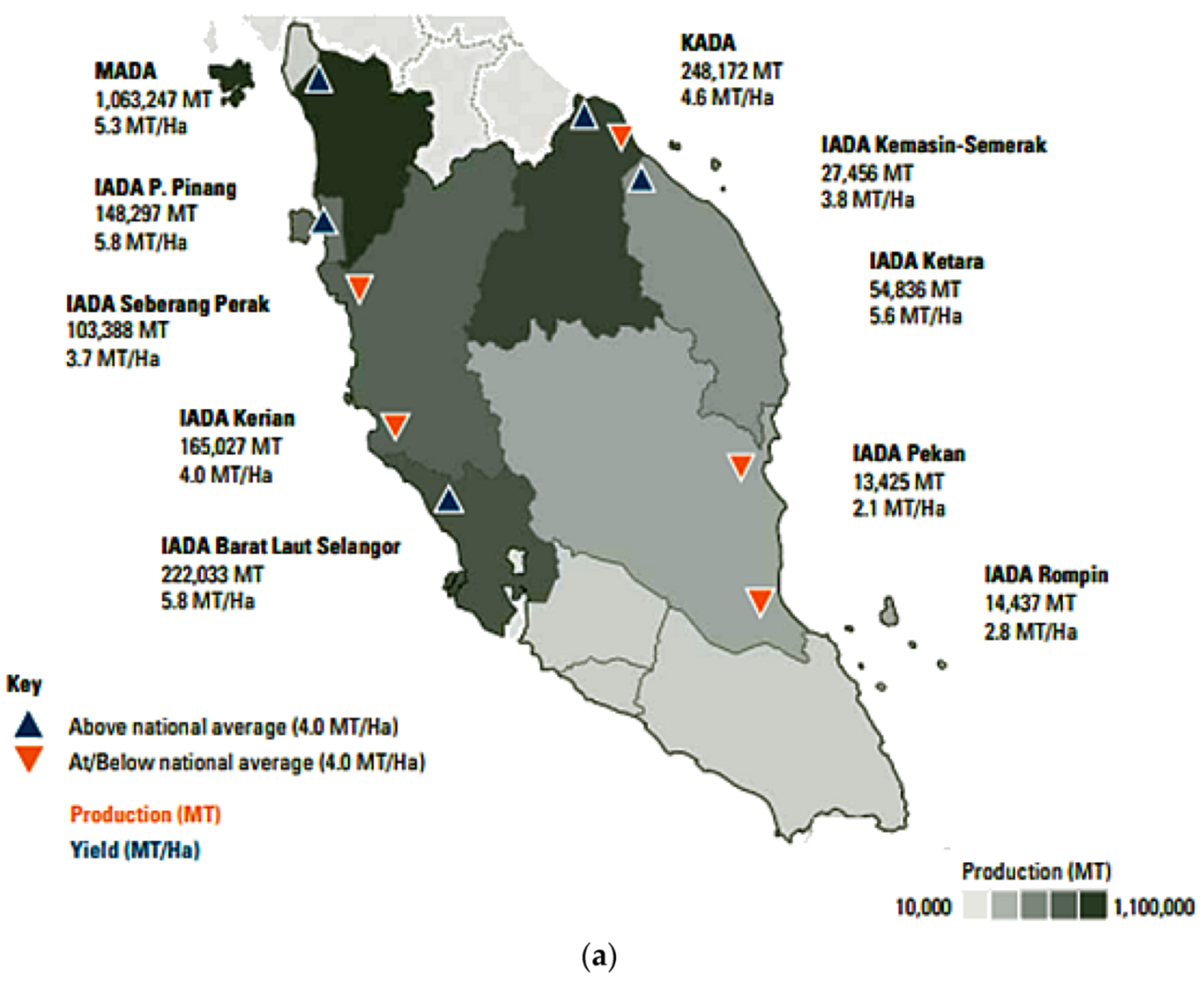
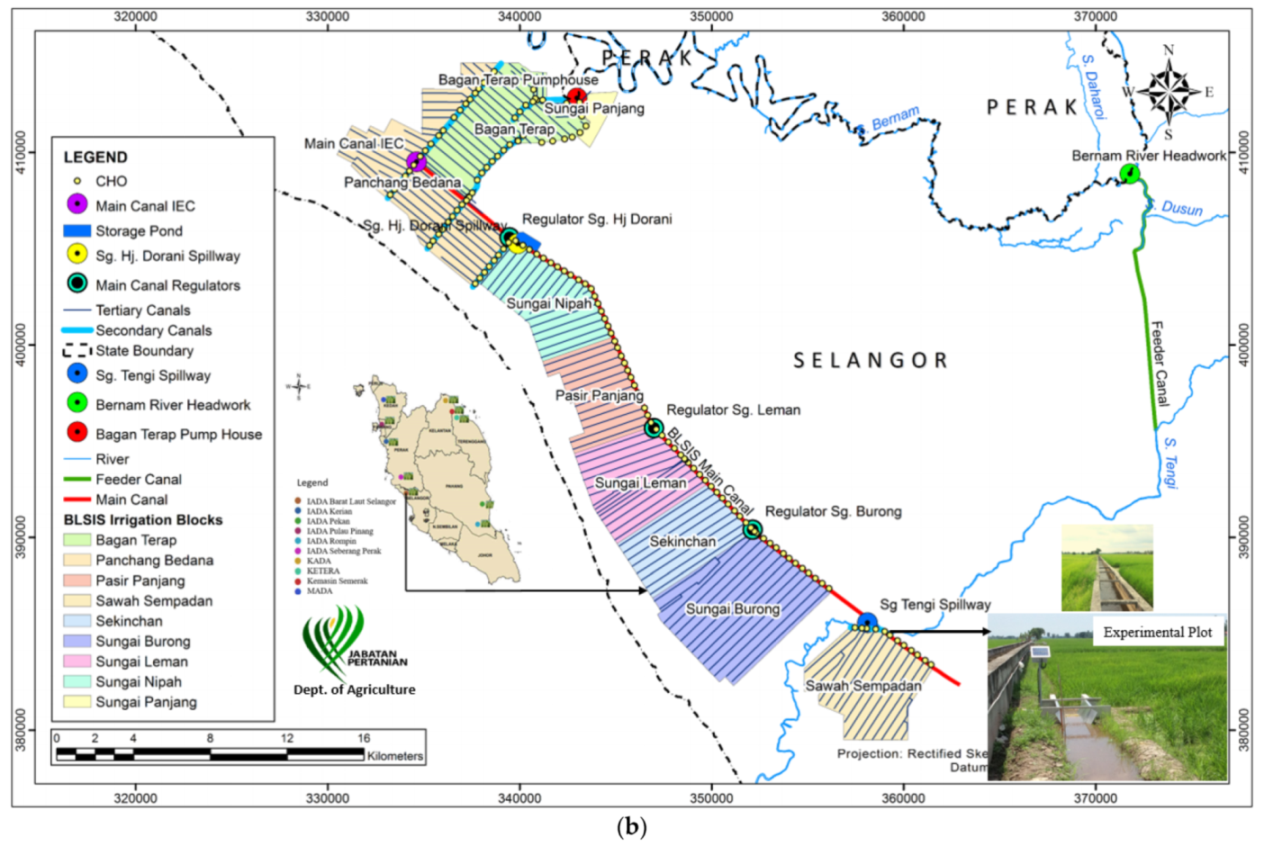

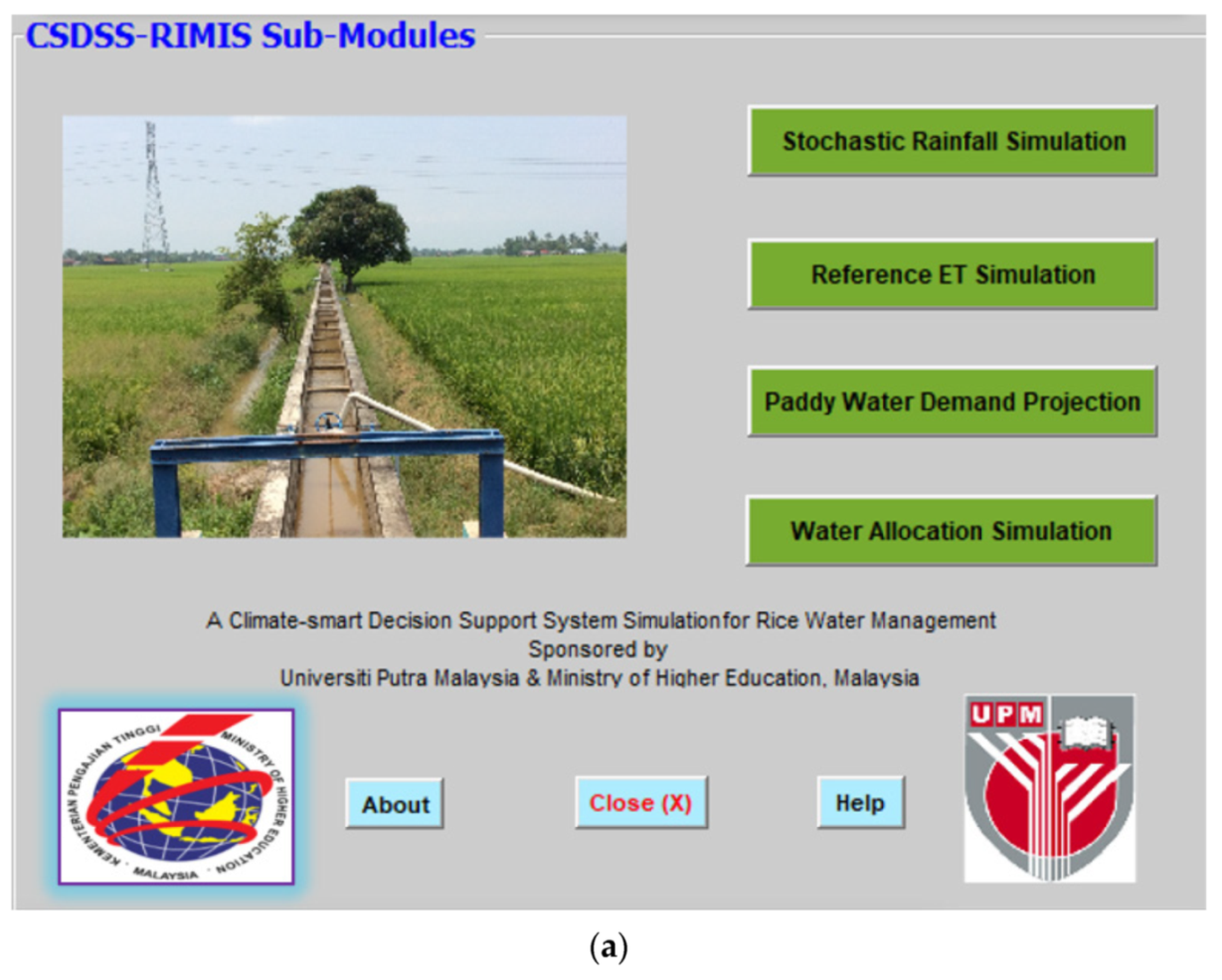

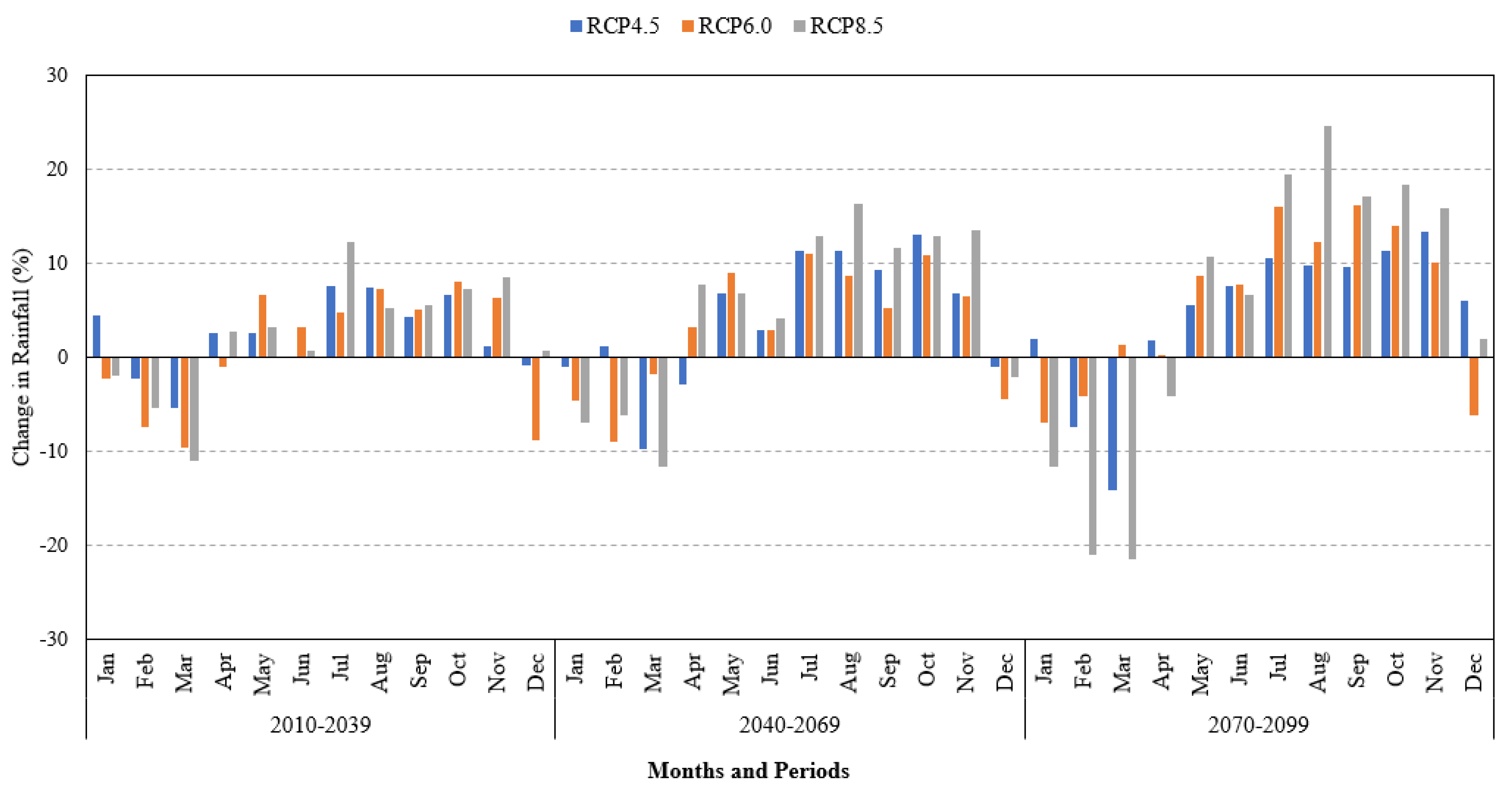

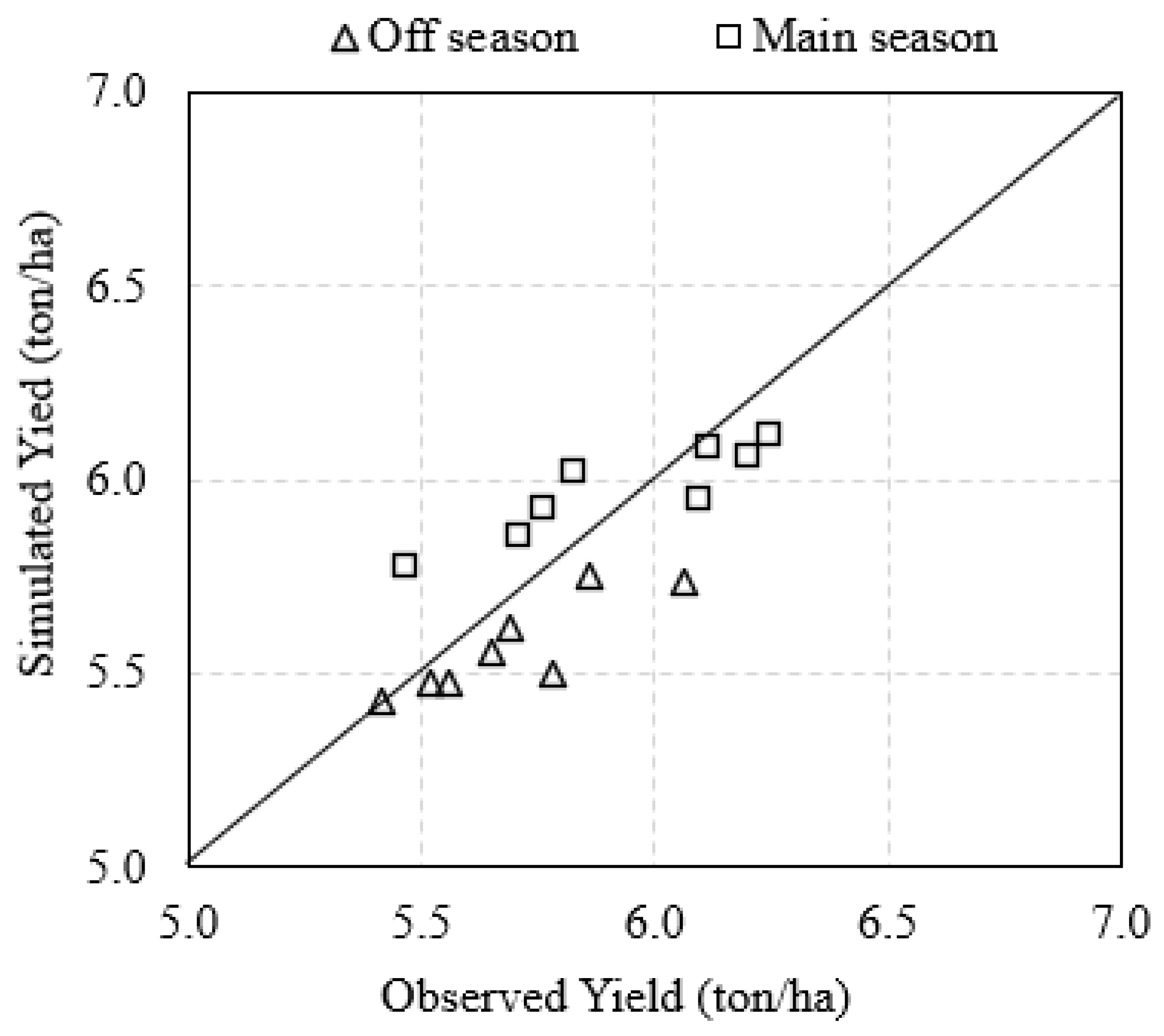
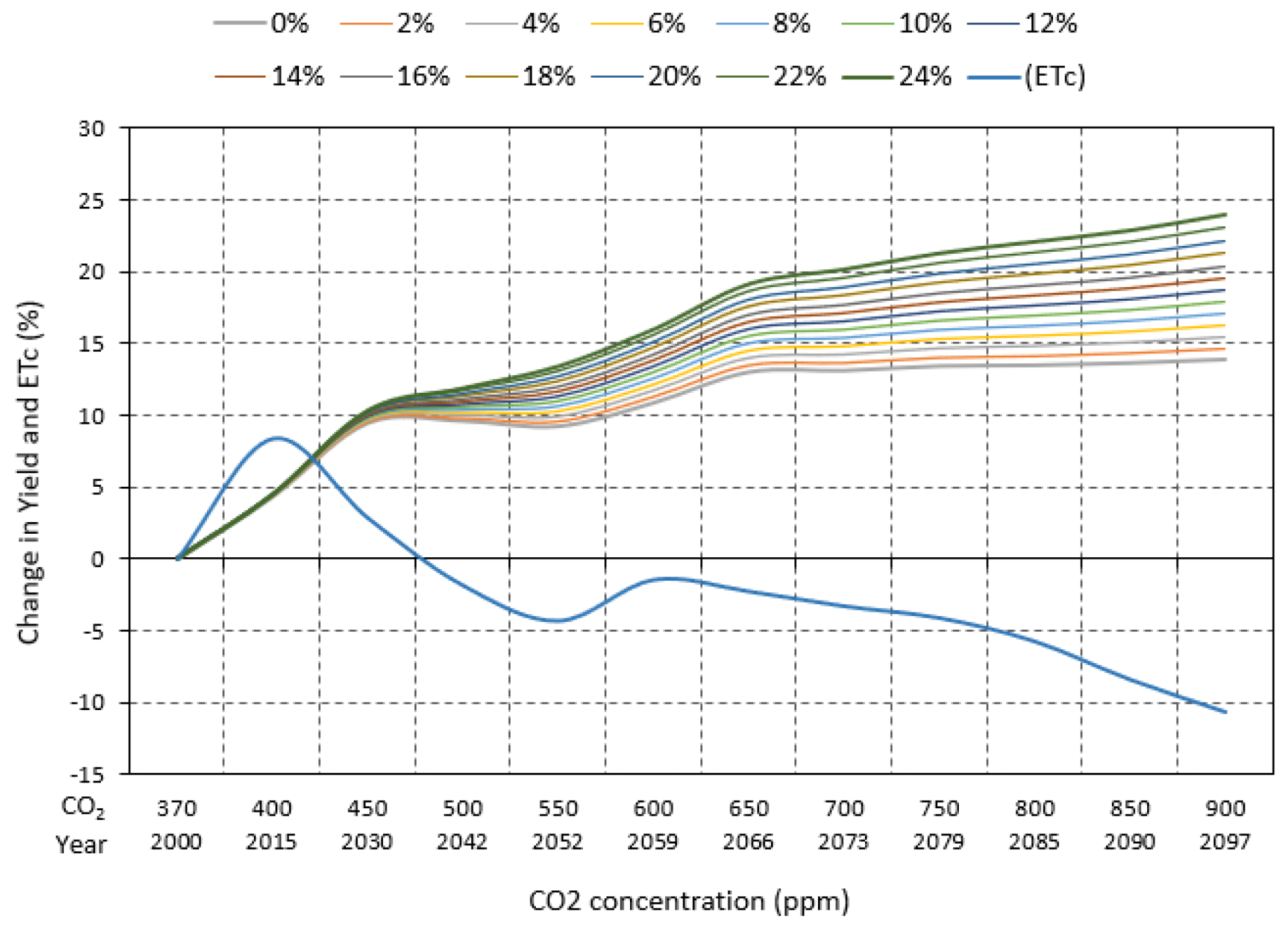
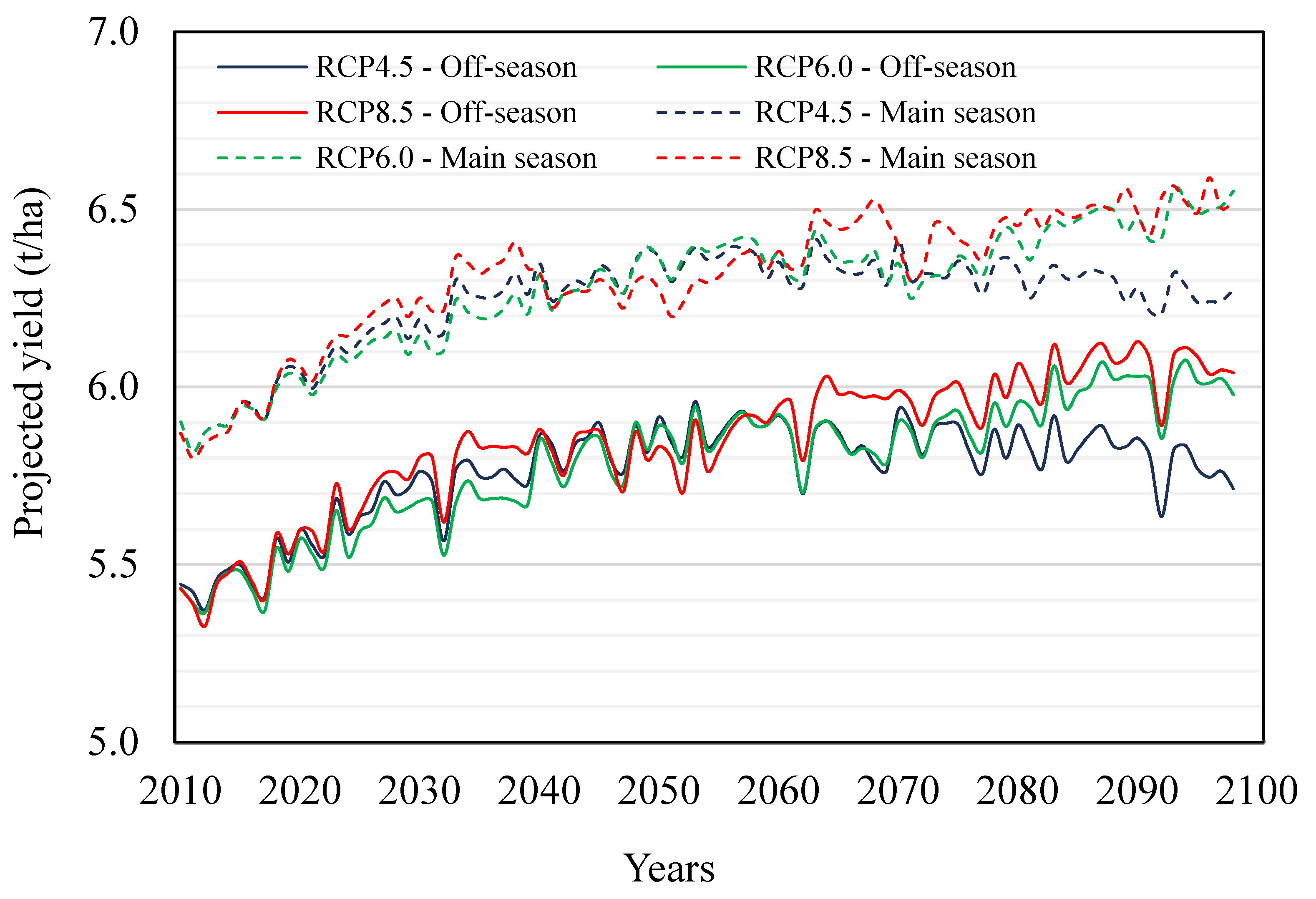
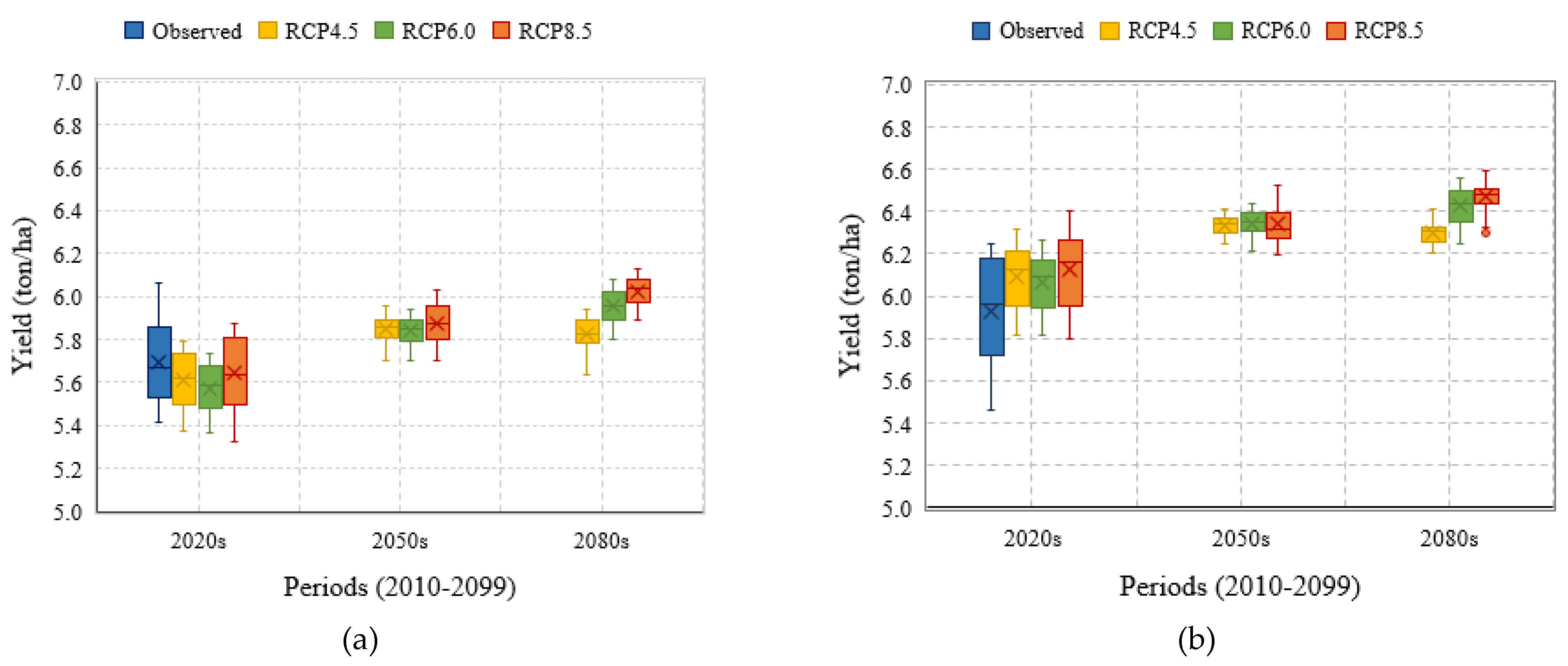
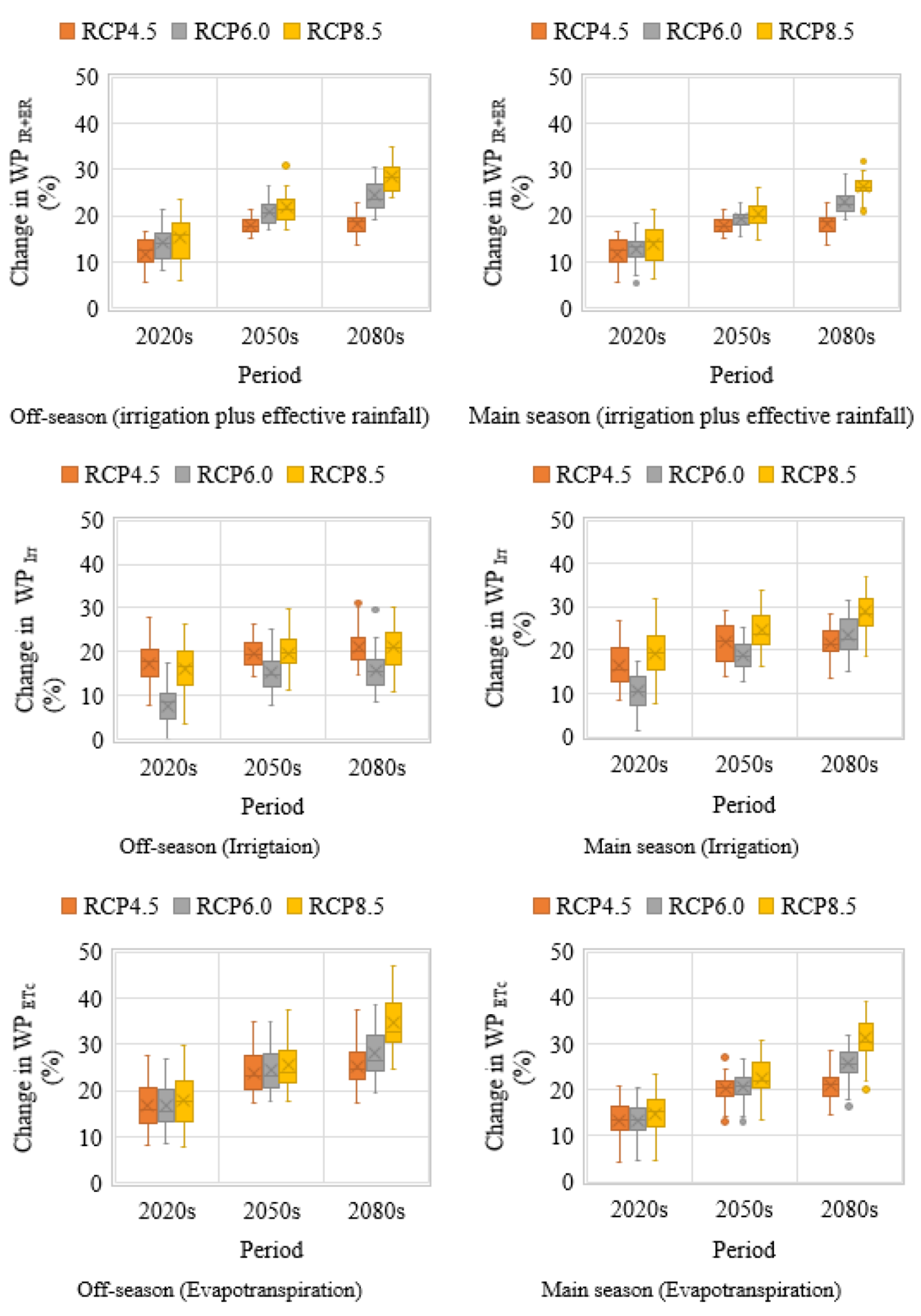
| Parameter Description | Value | |
|---|---|---|
| Main Season (July to October) | Off Season (January to April) | |
| Base temperature (°C) | 10 | 10 |
| Upper temperature (°C) | 30 | 30 |
| Initial canopy cover (%) | 10 | 6.5 |
| Time from sowing to emergence (GDD) | 152 | 117 |
| Maximum canopy coverage (%) | 95 | 90 |
| Time between sowing and flowering (GDD) | 1302 | 1135 |
| Duration of flowering stage (GDD) | 136 | 164 |
| Time between sowing and senescence initiation (GDD) | 1491 | 1273 |
| Time between sowing and maturity (GDD) | 1891 | 1681 |
| Effective minimum root depth (m) | 0.30 | 0.30 |
| Effective maximum root depth (m) | 0.60 | 0.55 |
| Normalized water productivity due to ETo and CO2 (g m−2) | 15 | 16 |
| Harvest index (HIo) | 44 | 38 |
| RCP Scenario | Time Period | CO2 Concentration (ppm) | ΔRF (%) | ΔTmin (°C) | ΔTmax (°C) | ΔWs (m s −1) | ΔRH (%) |
|---|---|---|---|---|---|---|---|
| Baseline 1976–2005 | 369 | 146.30 | 23.90 | 31.50 | 1.10 | 79.90 | |
| RCP4.5 | 2010–2039 | 423 | 2.37 | 0.72 | 0.62 | 0.04 | −0.07 |
| 2040–2069 | 495 | 4.01 | 1.33 | 1.19 | 0.01 | 0.03 | |
| 2070–2099 | 532 | 4.69 | 1.69 | 1.50 | 0.01 | 0.03 | |
| RCP6.0 | 2010–2039 | 418 | 1.02 | 0.64 | 0.55 | 0.07 | 0.18 |
| 2040–2069 | 494 | 3.15 | 1.21 | 1.05 | 0.10 | 0.18 | |
| 2070–2099 | 612 | 5.78 | 1.84 | 1.71 | 0.07 | 0.27 | |
| RCP8.5 | 2010–2039 | 432 | 2.34 | 0.79 | 0.70 | 0.78 | −0.16 |
| 2040–2069 | 572 | 4.94 | 1.85 | 1.75 | 0.76 | −0.25 | |
| 2070–2099 | 799 | 4.73 | 3.21 | 3.01 | 0.85 | −0.38 |
Publisher’s Note: MDPI stays neutral with regard to jurisdictional claims in published maps and institutional affiliations. |
© 2021 by the authors. Licensee MDPI, Basel, Switzerland. This article is an open access article distributed under the terms and conditions of the Creative Commons Attribution (CC BY) license (https://creativecommons.org/licenses/by/4.0/).
Share and Cite
Houma, A.A.; Kamal, M.R.; Mojid, M.A.; Zawawi, M.A.M.; Rehan, B.M. Predicting Climate Change Impact on Water Productivity of Irrigated Rice in Malaysia Using FAO-AquaCrop Model. Appl. Sci. 2021, 11, 11253. https://doi.org/10.3390/app112311253
Houma AA, Kamal MR, Mojid MA, Zawawi MAM, Rehan BM. Predicting Climate Change Impact on Water Productivity of Irrigated Rice in Malaysia Using FAO-AquaCrop Model. Applied Sciences. 2021; 11(23):11253. https://doi.org/10.3390/app112311253
Chicago/Turabian StyleHouma, Abdusslam A., Md Rowshon Kamal, Md Abdul Mojid, Mohamed Azwan Mohamed Zawawi, and Balqis Mohamed Rehan. 2021. "Predicting Climate Change Impact on Water Productivity of Irrigated Rice in Malaysia Using FAO-AquaCrop Model" Applied Sciences 11, no. 23: 11253. https://doi.org/10.3390/app112311253
APA StyleHouma, A. A., Kamal, M. R., Mojid, M. A., Zawawi, M. A. M., & Rehan, B. M. (2021). Predicting Climate Change Impact on Water Productivity of Irrigated Rice in Malaysia Using FAO-AquaCrop Model. Applied Sciences, 11(23), 11253. https://doi.org/10.3390/app112311253







